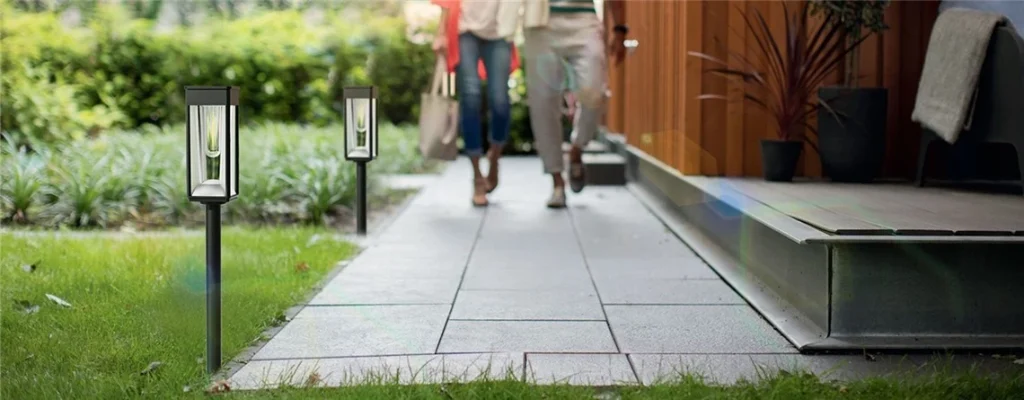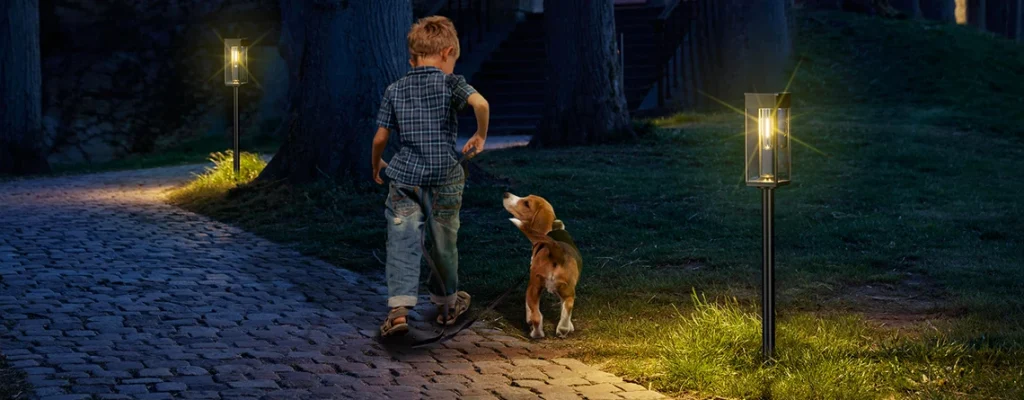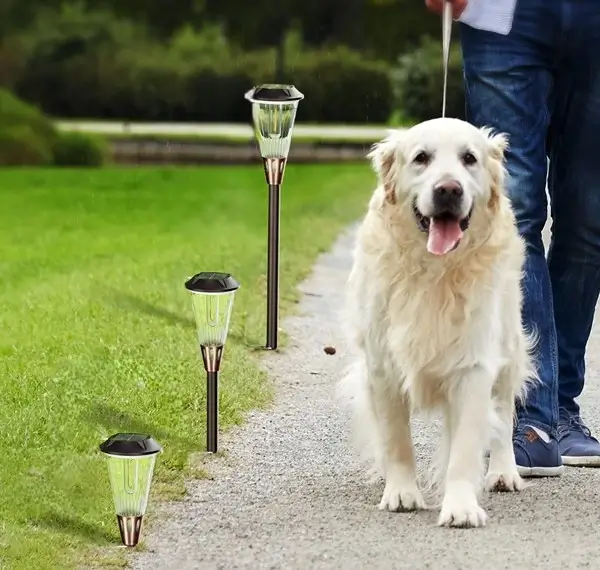Winter evenings in American backyards often mean gathering around a fire pit or outdoor fireplace, swapping stories, and soaking up the warmth. But when the sun dips, practical issues creep in: stumbling in the dark while grabbing firewood, struggling to see the firebox clearly, or worrying about traditional lights catching a stray spark. Solar lights, with their fire-resistant builds and no-cord freedom, offer a smart fix. They’re safe, eco-friendly, and can dial up the cozy vibes without risking burns or trips. Here’s how to craft a solar-powered lighting setup that keeps your fire pit or fireplace both functional and inviting, based on real-world setups and a bit of backyard know-how.

Safety-First Lighting Layout
The last thing you want when tending a fire is to trip over a log or burn your hand because you couldn’t see what you were doing. A well-planned lighting layout around your fire pit or outdoor fireplace can make all the difference. Solar lights, especially those built with heat-resistant or flame-retardant materials, are perfect for keeping the ground and key areas visible without adding fire risks.
Here’s a practical setup for safety:
- Pathway lights for ground coverage: Place high-temperature-resistant solar pathway lights about 1.5 meters from the fire pit’s edge. These cast a soft, downward glow (100-200 lumens) to light up the ground, preventing trips over stray rocks or uneven terrain while you’re hauling wood or poking the fire. Look for models with polycarbonate or ABS bodies rated for heat up to 200°F.
- Wall-mounted spotlights for firewood stacks: Install a solar spotlight next to your woodpile, angled downward to illuminate logs without shining in your eyes. These typically push 400-800 lumens, making it easy to grab firewood safely, and their high placement (6-8 feet) keeps them clear of flames.
- Magnetic mini-lights for fireboxes: Stick a small magnetic solar light (50-100 lumens) onto the metal frame of your outdoor fireplace. It’s perfect for checking fire strength or rearranging logs without getting too close to the heat. Heat-resistant casings ensure they won’t melt or crack.
I’ve seen a neighbor use this exact combo around their fire pit, and it’s a game-changer—no more fumbling in the dark or guessing where the logs are. Just make sure the lights are IP65-rated to handle ash and occasional splashes from winter rain.
Balancing Ambiance and Function
A fire pit’s glow is half the charm of a winter night, but the right solar lights can amplify that cozy feel without stealing the show. The trick is choosing lights that complement the fire’s warm flicker while still doing their job. Plus, you need to keep them safe from sparks and heat, which means strategic placement and fire-safe materials.
Here’s how to nail the vibe while staying practical:
- Fire-resistant string lights for warmth: Wrap solar-powered string lights—think copper-wire LEDs with flame-retardant coatings—around a pergola or canopy above the fire pit. Go for warm yellow (2700-3000K) to echo the fire’s glow, creating a snug, inviting atmosphere. These use just 1-2W and run 8-10 hours on a full charge, perfect for long evenings.
- High placement for safety: Mount all lights at least 1.8 meters (6 feet) above ground to dodge stray sparks. String lights on overhead structures and spotlights on posts or walls stay well out of the fire’s reach, reducing risk of damage.
- Remote solar panels for efficiency: Position photovoltaic panels away from the fire pit—ideally in a sunny spot like a nearby roof or open lawn—connected via 10-15-foot extension cables. This keeps charging efficiency high (20-23% with monocrystalline panels) by avoiding heat or smoke interference.
One friend strung warm-toned solar lights over their patio fireplace, and it turned their chilly gatherings into something straight out of a holiday card. The key? Keeping panels clear of the fire zone so they actually charge.
Choosing the Right Solar Lights for Fire Pits
Not all solar lights are cut out for the heat and hazards of a fire pit or outdoor fireplace. You need models built to withstand high temperatures and occasional sparks while delivering enough light to be useful. Most standard solar lights use ABS plastic, but for fire proximity, look for flame-retardant polycarbonate or metal-alloy casings with heat ratings above 150°F.

Battery size matters too. Aim for 1500-3000mAh LiFePO4 batteries, which hold up better in cold winters than NiMH and deliver 8-12 hours of light even after a cloudy day. Motion sensors can stretch runtime by kicking on only when you’re near the fire or woodpile, saving juice for all-night ambiance.
What to prioritize when shopping:
- Heat resistance: Flame-retardant bodies (polycarbonate, metal) for durability near flames.
- Brightness range: 100-200 lumens for paths, 400-800 for spots, 20-50 per string light bulb.
- Weatherproofing: IP65 or higher to handle rain, snow, and ash.
- Battery life: 1500mAh+ for 8+ hours; LiFePO4 for cold-weather reliability.
- Mounting options: Magnetic or clip-on for fireplaces, stakes for paths, hooks for strings.
A quick Amazon scan shows sets like the Sunforce FireGuard line hitting these marks for $30-60, with 4.5-star reviews backing their toughness around fire pits.
Practical Tips for Installation and Maintenance
Setting up solar lights around a fire pit isn’t rocket science, but a few tricks make it foolproof. Start by mapping your layout—walk the area at night to spot where shadows pool or tripping risks lurk. Install pathway lights in a loose circle, about 3-5 feet apart, to create a safe perimeter without crowding the fire’s glow.
For maintenance, clean panels every couple of months with a damp cloth to clear ash or dust, which can cut efficiency by 20%. Check battery compartments for corrosion, especially after wet winters, and swap batteries every 2-3 years for peak performance. If you’re in a cloudy region, consider hybrid solar-USB models for backup charging during gray streaks.
Installation and care tips:
- Angle panels right: Tilt 20-30° toward the sun’s path for max charge; avoid fire pit heat zones.
- Secure mounts: Use heavy-duty stakes or magnetic clips to withstand wind or accidental bumps.
- Winter prep: Store string lights indoors during deep freezes to protect wiring; fixed lights are fine down to -10°F.
A colleague’s fire pit setup survived a snowy Colorado winter with zero issues after he angled panels properly and used heat-resistant models. Small tweaks, big payoff.
Why Solar Lights Make Sense for Fire Pits
Beyond safety, solar lights bring practical perks. They’re cord-free, so no digging trenches or risking exposed wires near flames. They slash energy costs—zero dollars to run once installed—and cut your carbon footprint, with each light saving about 10-15 kg of CO2 annually compared to wired. Plus, they’re renter-friendly: no permanent mounts, no landlord fuss.
The ambiance factor can’t be overstated. Warm-toned string lights or soft pathway glows turn a functional fire pit into a backyard retreat, making hot cocoa nights feel like an event. And with fire-resistant builds, you’re not sweating every spark.
Warm Glow, Safe Nights with Solar
Solar lights around your outdoor fireplace or fire pit solve the big pain points: no more tripping while fetching wood, squinting into the firebox, or worrying about flammable fixtures. Pathway lights guide your steps, spotlights make woodpiles accessible, and string lights add that warm, inviting touch—all without cords or fire risks. They’re not perfect for every scenario (heavy shade or constant clouds might call for hybrids), but for most American backyards, they’re a safe, sustainable way to elevate winter gatherings. Set them up right, and your fire pit becomes the heart of cozy, worry-free nights.


Leave a Reply